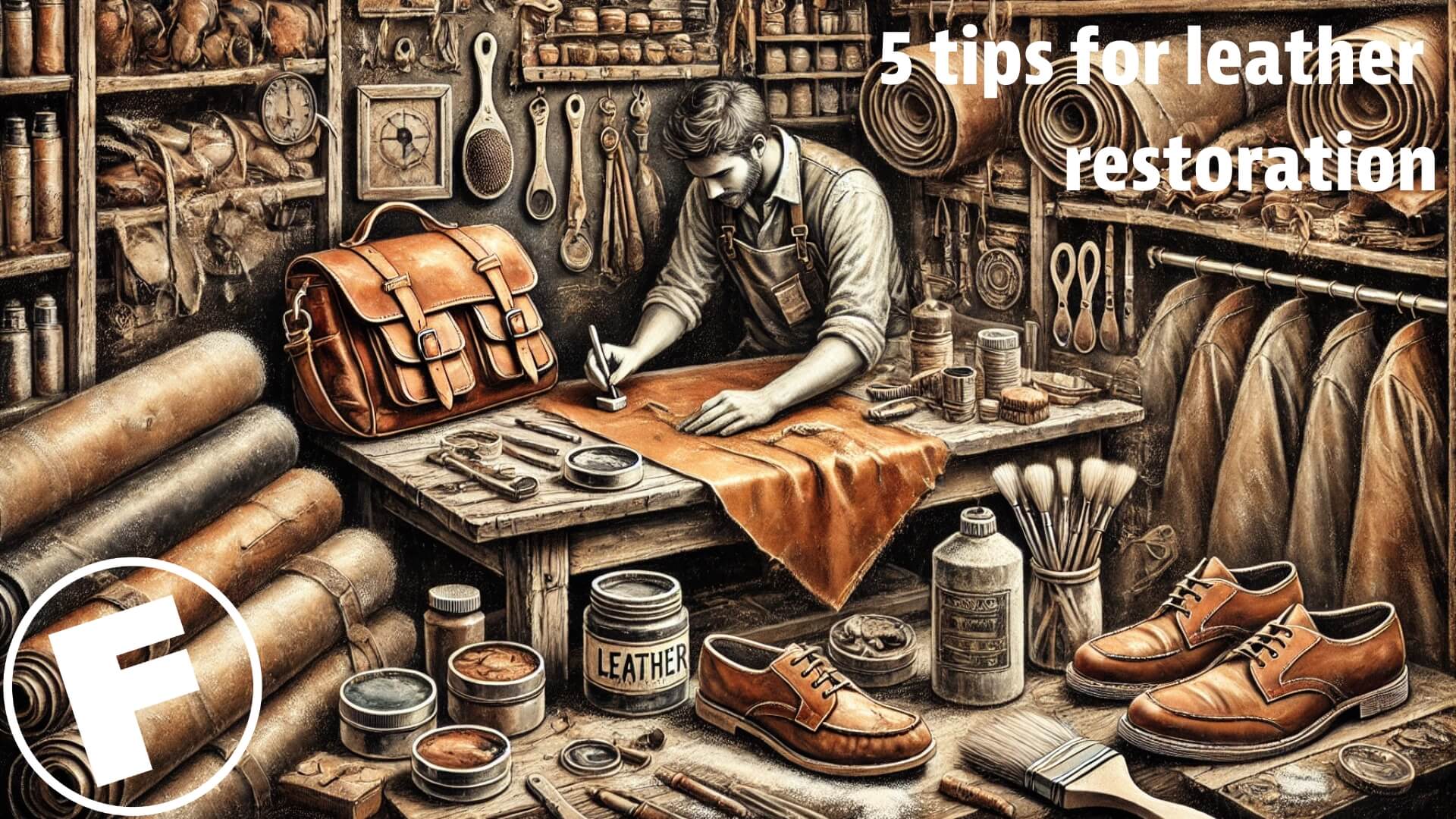5 Tips for Leather Restoration
Leather items, whether they’re sofas, jackets, bags, or car seats, often become more cherished with age. However, they also wear and tear, fading in color, drying out, or developing cracks and scratches over time.
Restoring leather can seem daunting, but with the right techniques, you can breathe new life into your leather pieces and extend their lifespan by years. Here are five essential tips for bringing your leather back to its former glory.

Clean Thoroughly Before Starting
Before diving into repairs or conditioning, clean your leather meticulously to remove dirt, oils, and any grime that has built up. Dirt and oils not only impact the leather’s appearance but also hinder the effectiveness of restoration products.
- Use the Right Cleaner: Opt for a pH-balanced leather cleaner or a mild soap mixed with water for a DIY approach. Avoid harsh detergents or alcohol-based cleaners, which can dry out and damage leather.
- Method: Apply the cleaner with a soft, lint-free cloth, gently rubbing in circular motions. Focus on any stained or heavily used areas, like armrests or edges.
- Drying: Pat the surface with a clean towel to remove excess moisture, and let the leather air-dry completely. Avoid heat sources, as they can cause the leather to crack or become brittle.
Regular cleaning is crucial to maintaining the leather’s integrity, especially on frequently touched surfaces like steering wheels or armchairs.
Condition the Leather to Restore Moisture
Leather is prone to drying out, especially in dry or hot climates, leading to cracks and stiffness. Conditioning helps replenish the natural oils that keep leather supple and soft.
- Select a High-Quality Conditioner: Use a specialized leather conditioner or cream, typically containing natural oils like lanolin. Look for non-greasy formulas that absorb well and won’t leave a sticky residue.
- Application Technique: Apply a small amount of conditioner to a soft cloth, and work it into the leather in circular motions. Be conservative with the amount—over-conditioning can clog pores and lead to stickiness.
- Frequency: Condition your leather every 6 to 12 months, depending on use and exposure. High-traffic items, like leather furniture or car interiors, benefit from more frequent conditioning.
Conditioning revitalizes the leather’s natural sheen and softens its texture, enhancing both comfort and longevity.
Repair Minor Scratches and Scuffs Carefully
Scratches, scuffs, and minor cracks can make your leather look aged and worn. Fortunately, many of these imperfections are easy to fix with a few simple products.
- Leather Repair Kits: These kits contain color-matched fillers that can be applied to scratches and then blended to match the surrounding leather. They’re especially helpful for colored leather items.
- Use a Soft Cloth: For minor scuffs, gently rub a small amount of leather oil or conditioner into the scratch. Sometimes, this is enough to make the scratch disappear.
- Deep Scratches: For more significant damage, apply a color-matched leather balm after cleaning. Let it dry fully, then buff the area to blend the repair seamlessly.
By tackling these repairs regularly, you’ll prevent minor issues from worsening and maintain your leather’s original appearance.
Restore Color with Leather Dye or Balm
Over time, leather can fade due to sun exposure, wear, and aging. A leather dye or balm can refresh the color, making it look as vibrant as when you first bought it.
- Choose the Right Color: Match the color of the dye or balm to your leather as closely as possible. Test it on an inconspicuous area first to ensure a good match.
- Application Process: Use a soft sponge or cloth to apply the dye in thin layers, building up color gradually. Allow each layer to dry before applying the next to avoid streaks.
- Seal the Color: After dyeing, apply a leather finisher to seal the color and add a protective layer, preventing future fading.
Regular application of a color-restoring balm will keep your leather vibrant and prevent uneven fading, particularly on items frequently exposed to sunlight.
Protect with a Leather Sealant
Once you’ve restored your leather, protect it from future wear, spills, and stains with a leather sealant. This final step can dramatically extend the life of your leather, keeping it in pristine condition.
- Choose a Water-Resistant Sealant: Look for leather-specific sealants that repel water and stains without altering the texture or color of the leather.
- Apply in Thin Layers: With a clean cloth, apply a light layer of sealant, ensuring even coverage. Allow it to dry completely between applications for maximum effectiveness.
- Reapply as Needed: For leather items frequently used outdoors or in high-contact areas, reapply the sealant every few months.
A quality leather sealant forms an invisible barrier that helps protect against spills, sunlight, and scratches, making your leather easier to clean and maintain.
Let’s be real: Trust the pros to restore your valued leather belongings
Get in touch with your local Fibrenew professional for all your leather, plastic, and vinyl repair needs.
Want to run a business that gives you incredible earning potential and the flexibility to take control of your time and life? Join the Fibrenew Family!
Check out our free Franchise Information Report for everything you need to know.
Also, enjoy these valuable resources on all things leather, plastic, and vinyl repair, franchising, sustainability, and more:
Leather Restoration FAQ
How can I restore the color of faded leather?
To restore faded leather, use a leather dye or color-restoring balm. Choose a shade that matches your leather closely, apply it in thin layers with a cloth, and let each layer dry before adding the next. After dyeing, use a leather finisher to seal the color and protect it from future fading.
Can I use any household products to clean or condition leather?
Some mild soaps and distilled water can be used in a pinch, but avoid household cleaners containing alcohol, vinegar, or harsh chemicals, as these can damage leather. Stick to leather-specific products when possible to ensure long-term protection and care.

